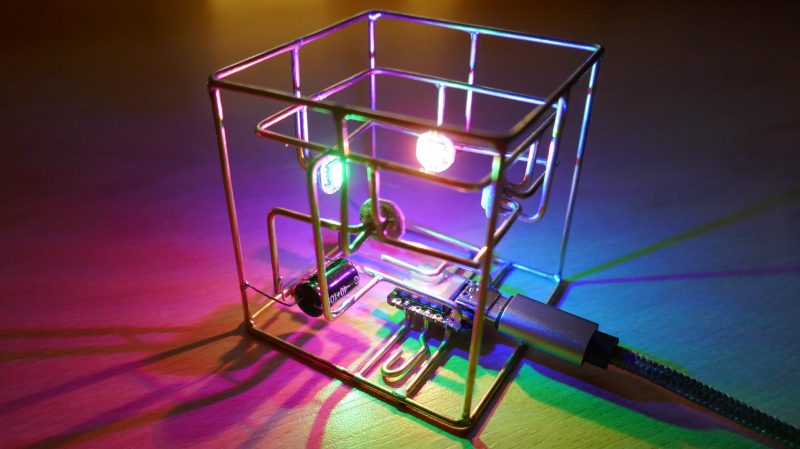Circuit sculpture is engineering and art all at play together. One must combine the functional with the aesthetically appealing. [EdwardA61] did just that with this enchanting lamp build.
Like many other circuit sculptures, the build relies on the aesthetic qualities of brass, though [EdwardA61] notes that copper wire can be used as well. Four WS2812B LEDs, in their bare PCB-mount form, are soldered into a circuit using the brass to carry the power and data signals as needed.
A Seeduino Xiao microcontroller is responsible for controlling the show, though relies on a typical PCB rather than a circuit sculpture in and of itself. It does provide for easy powering and programming however, with the benefit of its USB-C connector.
It’s a simple skeleton design, as so many circuit sculptures are, but it’s a form that we’ve come to love and appreciate. [EdwardA61] did a great job of photographing the build, too, showing how the colors on each LED interplay with each other as they’re cast on the table.
It’s a lamp we’d love to build ourselves, and we hope that [EdwardA61] follows through on plans to cast a similar design in clear resin, as well. If you’ve built your own artistically electrical sculptures, be sure to let us know!
















Why are the most of instructables are under CC-BY-NC-SA? For me, they are not opensource :(
What part stops it being open source for you?
the NC license doesn’t fit most definitions of open source.
Obviously it bars you from making and selling your own (and I think this is why many artists choose this license), but it goes further than that – ‘commercial purposes’ is pretty broad and most people aren’t inclined to test the limits of that. The only one that’s been tested is whether you can hire someone to make a copy for you – the answer was yes.
It’s probably the default, or it’s described in a way that amateurs with big dreams think it sounds like it will make them the most famous/money.
Nothing prevents you from a) politely asking the creator to change the license, or b) designing your own similar but different-enough lamp.
That’s the best idea if you want to sell these. Personally, I’d drop that microcontroller and use a USB-C PD trigger for the power connector and whatever voltage you need, then I’d use an AT-tiny of some sort to control the pwm. Some of those ATtiny packages are super small, almost invisibly so. I’m not sure what going on with those little brass loops hanging between rails, but I might try to make some sort of touch sensor out of them. Read the drop in voltage or capacitance when a finger is bridging them and use that to turn things on or off or change modes. Maybe that’s what is happening. I haven’t watched the video yet. It would take very little effort to recreate something like this in a different way that you can use for whatever you like. The most work is probably bending the brass to the exact sizes and shapes you need. Mock it up and write those lengths down for faster production later on.
i never got round to adding a video but yeah the brass loop is a button which can be used to switch between different colours and lighting effects.
And yeah the CC-BY-NC-SA is just the default license.
almost a year late but i just changed it
A “Cube Companion”. Have you been playing latroP?
Cube companion? Well, this was a triumph! Dare I say, a huge success?